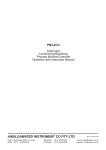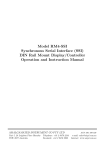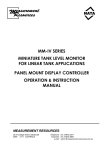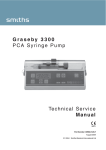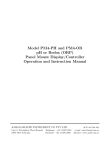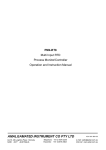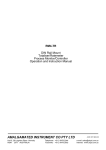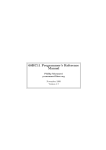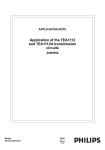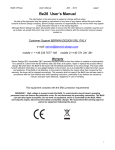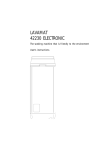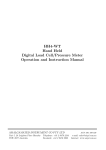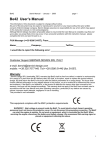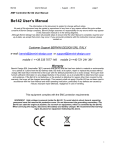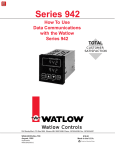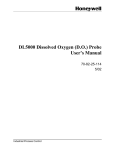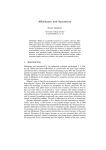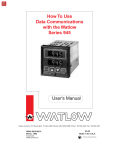Download Manual - Amalgamated Instrument Co Pty Ltd
Transcript
Model RM4-CO Conductivity/Resistivity/ppm DIN Rail Mount Display/Controller Operation and Instruction Manual AMALGAMATED INSTRUMENT CO PTY LTD Unit 5, 28 Leighton Place Hornsby NSW 2077 Australia Telephone: +61 2 9476 2244 Facsimile: +61 2 9476 2902 ACN: 001 589 439 e-mail: [email protected] Internet: www.aicpl.com.au Table of Contents 1 Introduction 3 2 Mechanical installation 8 3 Electrical installation 9 4 Function tables - summary of setup functions 13 5 Explanation of functions 17 6 Calibration 36 7 Specifications 43 8 Guarantee and service 44 2 of 44 RM4COMAN-2.3-0 1 Introduction This manual contains information for the installation and operation of the RM4 Conductivity /Resistivity/ppm Monitor. The RM4-CO is a general purpose auto ranging monitor which may be configured to accept an input from a range of conductivity cells with cell constants ranging from K=0.01 to K=100. Ranges and typical cell factors are shown in the table below. Note that the RM4-CO can only display 5 digits so mS/cm or mS/m ranges may have to be used at higher conductivities. Cell Range Guide Cell K uS/cm uS/m mS/cm mS/m K=0.01 0 – 125 @ 25o C 0 – 12,500 @ 25o C 0 – 0.125 @ 25o C 0 – 12.5 @ 25o C K=0.05 0 – 625 @ 25o C 0 – 62,500 @ 25o C 0 – 0.625 @ 25o C 0 – 62.5 @ 25o C K=0.1 0 – 1,250 @ 25o C 0 – 125,000 @ 25o C 0 – 1.25 @ 25o C 0 – 125 @ 25o C K=0.5 10 – 6,250 @ 25o C 1000 – 625,000 @ 25o C 0.01 – 6.25 @ 25o C 1 – 625 @ 25o C K=1.0 10 – 12,500 @ 25o C – 0.01 – 12.5 @ 25o C 1 – 1,250 @ 25o C K=2.0 20 – 25,000 @ 25o C – 0.02 – 25 @ 25o C 2 – 2,500 @ 25o C K=5.0 50 – 62,500 @ 25o C – 0.05 – 62.5 @ 25o C 5 – 6,250 @ 25o C K=10.0 100 – 125,000 @ 25o C – 0.1 – 125 @ 25o C 10 – 12,500 @ 25o C K=20.0 200 – 250,000 @ 25o C – 0.2 – 250 @ 25o C 20 – 25,000 @ 25o C K=50.0 500 – 625,000 @ 25o C – 0.5 – 625 @ 25o C 50 – 62,500 @ 25o C K=100.0 – – 1.0 – 1250 @ 25o C 100 – 125,000 @ 25o C factor A second input is provided for a temperature sensor to be used for automatic temperature compensation. The RM4-CO can accept 100Ω RTD (Pt100), 1000Ω RTD (Pt1000), LM335 or 100Ω thermistor or UU25J1 thermistor type temperature sensors. The default display can be set to either resistivity, conductivity, ppm or % by weight of Sodium Chloride. The display will toggle between temperature/conductivity or temperature/resistivity or temperature/ppm or temperature/%NaCl indication by pressing either the ^ or v button. The conductivity display units can be set to show either milliSiemens per metre, milliSiemens per centimetre, microSiemens per metre or microSiemens per centimetre. The resistivity display is in MΩ. RM4COMAN-2.3-0 3 of 44 Calibration, setpoint and other set up functions are easily achieved using the push buttons. Two standard inbuilt relays are provided for alarm/control, additional relays, retransmission and DC output voltage may also be provided. A special “blowdown” relay operation is available for units fitted with 2 relays. Unless otherwise specified at the time of order, your RM4 has been factory set to a standard configuration. Like all other RM4 series instruments the configuration and calibration are easily changed by the user. Initial changes may require dismantling the instrument to alter PCB links, other changes are made by push button functions. Full electrical isolation between power supply, conductivity/resistivity cell and retransmission output is provided by the RM4, thereby eliminating grounding and common voltage problems. This isolation feature makes the RM4 ideal for interfacing to computers, PLCs and other data acquisition devices. The single analog output option allows the choice of temperature or main display (conductivity or resistivity, %NaCl or PPM) output. The dual analog option allows both temperature and main display to be retransmitted. Analog outputs can be set for linear or logarithmic (up to 5 decades) output. The RM4 series of DIN Rail Mount Monitors are designed for high reliability in industrial applications. The high brightness LED display provides good visibility, even in areas with high ambient light levels. A feature of the RM4 is the programmable display brightness function. This allows the unit to be operated in low display brightness to reduce power consumption and improve readability in darker areas. To reduce power consumption in normal use the display can be programmed to automatically blank after a set time. When the display has blanked it can be returned to normal brightness by pressing any of the front pushbuttons and it will also return to normal brightness if a relay becomes activated. 1.1 Output options • Third relay rated 0.5A resistive 30VAC or DC. May be configures as form A or C if the third relay is the only option fitted • Fourth relay rated 0.5A resistive 30VAC or DC, form A • Isolated analog retransmission (12 or 16 bit versions available) configurable for 4–20mA, 0–1V or 0–10V. The analog output is configurable for retransmission or PI control 4 of 44 RM4COMAN-2.3-0 • Dual isolated analog retransmission (12 bit) configurable for 4–20mA, 0–1V or 0–10V. The first analog output is configurable for retransmission or PI control • Isolated RS485 or RS232 serial communications (ASCII (8 bit) or Modbus RTU) • Isolated Digital output - binary or BCD up to 16 bit, NPN or PNP output types available • Optional outputs are available in certain combinations e.g. Extra relay plus RS232 1.2 Conductivity measurement general information The instrument measures conductivity by placing an AC voltage across the two conductive surfaces (electrodes) of the conductivity cell and measuring the resulting AC current passing through the solution. For a given cell the AC current will increase as the conductivity of the solution increases. Any external voltage‘s present in the solution where the cell is located may cause inaccuracy and possibly instability in the reading. Typical sources of external voltages are level sensors and badly earthed electrical equipment such as pumps which have contact with the solution. The amount of AC current produced by the cell depends on the conductivity of the solution, the area of the cell electrodes and the distance between the electrodes. Any deposits which coat the cell will reduce the surface area available and therefore cause inaccurate readings. If cells are likely to become coated in use they will either have to be regularly cleaned or a non contact (inductive) type cell used. The use of non contact cells is not covered in this manual. If resistivity, ppm or percent are selected for viewing then the instrument simply measures conductivity using a conventional conductivity cell and converts this reading into the required display units. For ppm readings the conversion factor must be manually entered. Cell K factor - The instrument can only supply a given current range through the solution being measured therefore a cell designed for use with pure water will not be suitable for use in measuring very high conductivity since the instrument will not be capable of providing sufficient current for stable measurement at both extremes. This instrument requires that the resistance of the solution be 80Ω or higher for accurate measurement. To overcome this problem cells with different sensitivity levels are manufactured and this sensitivity level is known as the K factor. A cell with a higher K factor will use less current in a given solution than a cell with a lower K factor. See the table at the beginning of this chapter for typical measuring ranges for common K factor cells. The correct K factor cell should be chosen to suit the range required for measurement. Temperature compensation - Since conductivity changes with temperature the conductivity value displayed is referenced to a given temperature, usually 25o C. This means that the value being seen on the display is not necessarily the actual conductivity of the solution at that time but is the conductivity value which would be seen if the solution temperature was 25o C. If 25o C is not the required reference temperature i.e. if it is required to view what the conductivity reading would be at a different temperature then the required temperature value can be set at the Ch1 SOL and Ch2 SOL functions. This instrument allows for either manual or automatic temperature compensation. If no temperature sensor is used with the cell then the known temperature of the solution can be entered at the dEF "C function. If a temperature sensor is used the the reading obtained from this sensor can be used to automatically compensate for temperature changes in the solution. For process solutions whose temperature varies by more than a few degrees automatic temperature compensation is essential for accurate readings. For example water varies its conductivity at the rate of 2%/o C. RM4COMAN-2.3-0 5 of 44 1.3 Cell Installation When installing conductivity cells it is important to locate the cell in a position where the pipe is always completely full. The cell electrodes must be in complete contact with the water sample. If air is trapped around the cell electrode it will cause errors in the measurement. If oil, grease or any insulating material is allowed to build up on the electrode surface measurement errors will also occur. TBPS cells are suitable for installation into non metallic pipework. Ideally the cell should be installed from the side of the fitting. This method is less likely to be subjected to trapped air. The “T” fitting should be modified to allow the face of the cell to be flush with the inside of the fitting or pipe wall. It is acceptable for the cell to be slightly recessed when the cell is installed from the side of the fitting. Alternatively a 3/4” BSP hole may be drilled/threaded into the side of a fitting such as an existing elbow or “T” fitting. It is acceptable to install the cell from the top or bottom of the pipe or fitting provided care is taken to prevent air pockets or build up of sediment. In applications where the pipe diameter is less than 50mm the reduced sample volume around the cell electrodes may affect the accuracy of the reading. In these applications in-line calibration correction is recommended. For installation into the side wall of a tank, vessel etc. the information above applies. 6 of 44 RM4COMAN-2.3-0 TBLR, TBTH and TBTHHT cells are suitable for installation into metallic and non metallic pipework. The cell measurement is made on the inside of the cell body ensuring it is virtually unaffected by the surrounding sample or volume. The cell may be mounted in a horizontal or vertical position and is usually installed into a modified “T” fitting. The cell will provide a reliable and stable reading as long as there is a flow through the cell. Ideally the cell should be installed into an elbow installation with the flow entering the cell at the base opening and exiting from the holes around the perimeter. This method will provide a fast response. Alternatively the cell may be installed across the flow (not suitable for TBLR type cells or K=10.0 TBTH cells). This will provide a stable and accurate measurement, but the response time will be slower. In most applications this will not present a problem. These cells are also suitable for installation into sample flow lines. These are usually installed in a flow bypass or a sample to waste arrangement. Sample line measurement usually provides a slower response, but has the advantage of allowing the cell to be removed without disturbing the process. RM4COMAN-2.3-0 7 of 44 2 Mechanical installation The instrument is designed for DIN rail mounting. The instrument clips on to 35mm DIN standard rails (EN50022). Cut the DIN rail to length and install where required. To install the instrument simply clip onto the rail as shown below. To remove the instrument lever the lower arm downwards using a broad bladed screwdriver to pull the clip away from the DIN rail. 141mm 44mm I 2 3 4 91mm Rail 8 of 44 RM4COMAN-2.3-0 3 3.1 Electrical installation Electrical installation The RM4 Meter is designed for continuous operation and no power switch is fitted to the unit. It is recommended that an external switch and fuse be provided to allow the unit to be removed for servicing. The plug in, screw type, terminal blocks allow for wires of up to 2.5mm2 to be fitted. Connect the wires to the appropriate terminals as indicated below. Refer to connection details provided in this chapter to confirm proper selection of voltage, polarity and input type before applying power to the instrument. When power is applied the instrument will cycle through a display sequence indicating the software version and other status information, this indicates that the instrument is functioning. Acknowledgement of correct operation may be obtained by applying an appropriate input to the instrument and observing the reading. The use of screened cable is recommended for signal inputs. For connection details of optional outputs refer to the separate “RM4 Din Rail Meter Optional Output Addendum” booklet supplied when options are fitted. Instrument label (example) RM4COMAN-2.3-0 9 of 44 3.2 Electrical connection examples If output options are fitted refer to the ”RM4 DIN Rail Meter Optional Output Addendum” booklet for connection details. Conductivity/Resistivity/ppm Cells - The cell is connected to terminals 5 and 6. Terminal 5 is the input connection i.e. the current input from the cell. Terminal 6 is the output connection. If using a centre core type cell the centre core wire should be connected to Terminal 5. Ensure that the PRbE CNSt function has been correctly set for probe type. A.I.C. cells with temperature compensation sensors are all wired with Red, Black, Blue and Yellow (or White on older models) inner core cable. See the note below for details of TBPS cells without temperature compensation sensors. The wiring connections are as below. Cell wiring colour codes AIC cells SDI cells Cell in Blue Black Cell out Yellow (or White) White Temperature + Red Red Temperature - Green (or Black) Green Shield n/a Clear + TEMP IN OUT CELL Junction head connector layout for TBTH cell. Wires :Temperature: Red plus Black or Green Cell: Blue plus Yellow or White TBTH Cell TBLR Cell TBPS Cells Outer Electrodes or Cell Out yellow or white wire Centre Electrodes or Cell In blue wire 10 of 44 Cells In and Out blue & yellow (or white) wires may be connected either way around with TBPS types RM4COMAN-2.3-0 Conductivity cell wiring - Ensure correct K factor is set at the PRbE CNSt function. Temperature sensor wiring - 2 or 3 wire RTD (Pt100 or Pt1000) sensors, 100Ω thermistor or UU25J1 thermistor types can be accepted. Wiring for these sensors is shown below. Ensure that links for the temperature probe are set and that the "C tYPE function is set to the appropriate type. RM4COMAN-2.3-0 11 of 44 3.3 Configuring the output board If changes to the link settings are required on the option board the circuit board will need to be removed from the case. Remove the circuit board from the case following the instructions below. 3.4 Temperature range link selection Dismantle the instrument as described in section 3.3. Insert the links into the appropriate location on the pin header to suit the sensor required. 12 of 44 RM4COMAN-2.3-0 4 Function tables - summary of setup functions Note: the order in which the functions appear on the display may not be exactly as shown below. The availability and order of functions is determined by choice of function settings and options fitted. Functions in this first table are available in FUNC or CAL mode. Display Function Range Default Your Ref/Page record AxLo Low setpoint value for designated alarm relay x Any display value or OFF OFF See 4.1 5.1 / 19 AxHi High setpoint value for designated alarm relay x Any display value or OFF OFF See 4.1 5.2 / 19 AxHY Hysteresis value for the designated alarm relay x. 0 to 9999 10 See 4.1 5.3 / 20 Axtt Trip time delay for the designated alarm relay x. 0 to 9999 0 See 4.1 5.4 / 21 Axrt Reset time delay for the designated alarm relay x. 0 to 9999 0 See 4.1 5.5 / 21 Axn.o or Axn.c Alarm relay x action to normally open (de-energised) or normally closed (energised) Axn.o or Axn.c Axn.o See 4.1 5.6 / 21 brGt Display brightness level 1 to 15 15 5.7 / 22 duLL Automatic brightness switching 0 to 15 1 5.8 / 22 d.oFF SECS Auto display dimming timer 0 to 9999 0 5.9 / 22 REC_ Analog output option low display value (∗ Optional) Any display value 0 5.10 / 23 REC~ Analog output option high display value (∗ Optional) Any display value 1000 5.11 / 23 REC_ Ch2 Second analog output option low display value (∗ Optional) Any display value 0 5.12 / 23 REC~ Ch2 Second analog output option high display value (∗ Optional) Any display value 1000 5.13 / 23 (∗ Optional)—this function will only be accessible if the relevant option is fitted RM4COMAN-2.3-0 13 of 44 Functions in this second table are available only in CAL mode or if ACCS is set to ALL Display Function Range Default Your Ref/Page record drnd Display rounding 1 to 5000 1 5.14 / 24 dCPt Decimal point 0, 0.1 etc. 0 5.15 / 24 FLtr Digital filter 0 to 8 2 5.16 / 24 dOSE PERd Special dosing mode operation 0 to 600 0 5.17 / 25 "C tYPE Temperature sensor type NONE, 100, 1000, L335, t100 or 25J1 NONE 5.18 / 25 dEF "C Default temperature value 0.0 to 200.0 25.0 5.19 / 25 SOL SLPE Solution temperature compensation slope -6.00 to 0.00 -2.00 5.20 / 26 SOL "C Solution temperature compensation reference 0.0 to 100.0 25.0 5.21 / 26 PRbE CNSt Cell K factor 0.01, 0.05, 0.1, 0.5, 1.0, 2.0, 5.0, 10, 50 or 100 0.1 5.22 / 26 H.OFF or H.ON Hydrogen ion compensation H.OFF or H.ON H.OFF 5.23 / 27 CAL NULL Display null calibration n/a n/a 5.24 / 27 CAL1 First live input calibration scaling point Any display value n/a 5.25 / 27 CAL2 Second live input calibration scaling point Any display value n/a 5.26 / 27 "C NULL Temperature null calibration n/a n/a 5.27 / 27 CAL "C Temperature calibration n/a n/a 5.28 / 28 cond unit Conductivity measuring units uS.cm, uS.m, mS.cm or mS.m uS.cm 5.29 / 28 UCAL cond Conductivity uncalibration n/a n/a 5.30 / 28 UCAL RESt Resistivity uncalibration n/a n/a 5.31 / 28 UCAL ppm ppm uncalibration n/a n/a 5.32 / 29 (∗ Optional)—this function will only be accessible if the relevant option is fitted 14 of 44 RM4COMAN-2.3-0 UCAL Pcnt Percentage uncalibration n/a n/a 5.33 / 29 UCAL "C Temperature uncalibration n/a n/a 5.34 / 29 PPm FACt ppm conversion factor 0.200 to 2.000 0.560 5.35 / 29 SEt dISP Set display type cond, RESt, PPm or Pcnt cond 5.36 / 30 rec ctrI Analog output PI control (∗ Optional) on or OFF OFF 5.37 / 30 Pbut P button function (for instruments with front P button) NONE, Hi, Lo or HiLo NONE 5.38 / 30 ACCS Access mode OFF, EASY, NONE or ALL OFF 5.39 / 31 SPAC Setpoint access mode (∗ Optional) A1, A1-2 etc. A1 5.40 / 31 A1, A2 etc. Alarm relay operation mode cond, RESt, PPM, Pcnt, "C or dOSE cond REC Analog output mode (∗ Optional) cond, RESt, PPM, Pcnt or "C cond 5.42 / 32 REC2 Second analog output mode (∗ Optional) cond, RESt, PPM, Pcnt or "C cond 5.43 / 32 REC Analog output logarithmic or linear mode (∗ Optional) Lin, Log1, Log2, Log3, Log4 or Log5 Lin 5.44 / 33 REC Lo Analog output logarithmic start point (∗ Optional) 0.001, 0.01, 0.1, 1.0 or 10.0 0.001 5.45 / 34 REC2 Second analog output logarithmic or linear mode (∗ Optional) Lin, Log1, Log2, Log3, Log4 or Log5 Lin 5.46 / 34 REC2 Lo Second analog output logarithmic start point (∗ Optional) 0.001, 0.01, 0.1, 1.0 or 10.0 0.001 5.47 / 34 bAUd RAtE Baud rate for serial communications (∗ Optional) 300, 600, 1200, 2400, 4800, 9600, 19.2 or 38.4 9600 5.48 / 34 See 4.1 5.41 / 31 (∗ Optional)—this function will only be accessible if the relevant option is fitted RM4COMAN-2.3-0 15 of 44 PrtY Parity for serial communications (∗ Optional) NONE, EUEN or odd NONE 5.49 / 35 O.Put Output for serial communications (∗ Optional) dISP, Cont, POLL, A.buS or M.buS Cont 5.50 / 35 Addr Instrument address for serial communications (∗ Optional) 0 to 31 0 5.51 / 35 (∗ Optional)—this function will only be accessible if the relevant option is fitted 4.1 Relay table Record your relay settings in the table below Display Relay 1 Relay 2 Relay 3 Relay 4 AxLo AxHi AxHY Axtt Axrt Axn.o or Axn.c A1, A2 etc. 16 of 44 RM4COMAN-2.3-0 5 Explanation of functions The RM4 setup and calibration functions are configured through a push button sequence. The push buttons located at the front of the instrument are used to alter settings. Two basic access modes are available: FUNC mode (simple push button sequence) allows access to commonly set up functions such as alarm setpoints. CAL mode (power up sequence plus push button sequence) allows access to all functions including calibration parameters. Once CAL or FUNC mode has been entered you can step through the functions, by pressing and releasing the F push button, until the required function is reached. Changes to functions are made by pressing the or push button (in some cases both simultaneously) when the required function is reached. See the flow chart example on the following page. P P Entering FUNC Mode 1. Remove power from the instrument. Hold in the F button and reapply power. The display will indicate CAL as part of the "wake up messages" when the CAL message is seen you can release the button. F F 2. When the "wake up" messages have finished and the display has settled down to its normal reading press, then release the F button. P F 3. Within 2 seconds of releasing the F button press, then release the ^ and buttons together. The display will now indicate FUNC followed by the first function. No special power up procedure is required to enter FUNC mode. P F P 1. When the "wake up" messages have finished and the display has settled down to its normal reading press, then release the F button. F 2. Within 2 seconds of releasing the F button press, then release the ^ and buttons together. The display will now indicate FUNC followed by the first function. ^ Entering CAL Mode ^ Note: If step 1 above has been completed then the instrument will remain in this CAL mode state until power is removed. i.e. there is no need to repeat step 1 when accessing function unless power has been removed. RM4COMAN-2.3-0 17 of 44 Example: Entering FUNC mode to change alarm 1 high function A1Hi from OFF to 100 Press & release F then press ^v 1 0 0 F U N C Press & release F until Press & release Press & release F P or F until A 1 H i F U N C Press & release O F F ^ until E n d Example: Entering CAL mode to change decimal point function dCPt from 0 to 0.02 Switch off instrument Press & release F then press ^v .0 0 2 Press & hold F F U N C Switch on instrument Press & release F until Press & release Press & release F P or F until Hold F until C A L d C P t F U N C 0 Release F Press & release ^ until E n d Easy alarm relay adjustment access facility The display has an easy alarm access facility which allows access to the alarm setpoints simply by pressing the F button at the front of the instrument. The first setpoint will then appear and changes to this setpoint may be made to this setpoint via the ^ or v buttons. Press the F button to accept any changes or to move on to the next setpoint. Note: this easy access also functions in the same manner for the PI control setpoint (relay and/or analog PI output) if PI control is available. The instrument must be set in the manner described below to allow the easy access facility to work: 1. The R.INP function must be set to SPAC or the ACCS function must be set to EASY. 2. At least one alarm must have a setpoint, nothing will happen if all the alarm setpoints are set to OFF. 3. The SPAC function must be set to allow access to the relays required e.g. if set to A1-2 then the easy access will work only with alarm relays 1 and 2 even if more relays are fitted. 4. The instrument must be in normal measure mode i.e. if the instrument is powered up so that it is in CAL mode then the easy access will not function. If in doubt remove power from the instrument, wait for a few seconds then apply power again. 5. If the easy access facility is used then the only way to view or alter any other function settings is to power up via CAL mode i.e. there is no entry to FUNC mode functions unless the instrument is powered up in CAL mode. 18 of 44 RM4COMAN-2.3-0 Explanation of Functions 5.1 Alarm relay low setpoint Display: AxLo Range: Any display value or OFF Default Value: OFF Displays and sets the low setpoint value for the designated alarm relay x. Note x will be replaced by the relay number when displayed e.g. A1Lo for relay 1. Use this low setpoint function if a relay operation is required when the display value becomes equal to or less than the low setpoint value. To set a low alarm value go to the AxLo function and use the ^ or v push buttons to set the value required then press F to accept this value. The low alarm setpoint may be disabled by pressing the ^ and v push buttons simultaneously. When the alarm is disabled the display will indicate OFF. If the relay is allocated both a low and high setpoint then the relay will activate when the value displayed moves outside the band set by the low and high setpoints. The value at which the relay will reset is controlled by the AxHY function. Example: If A1Lo is set to 10 then relay 1 will activate when the display value is 10 or less. Display Value AxLo plus AxHY Relay activates at this value or below Relay resets above this value AxHY value AxLo Alarm low operation with hysteresis 5.2 Time Alarm relay high setpoint Display: AxHi Range: Any display value or OFF Default Value: OFF Displays and sets the high setpoint value for the designated alarm relay x. Note x will be replaced by the relay number when displayed e.g. A1Hi for relay 1. Use this high setpoint function if a relay operation is required when the display value becomes equal to or more than the low setpoint value. To set a high alarm value go to the AxHi function and use the ^ or v push buttons to set the value required then press F to accept this value. The high alarm setpoint may be disabled by pressing the ^ and v push buttons simultaneously. When the alarm is disabled the display will indicate OFF. If the relay is allocated both a low and high setpoint then the relay will activate when the value displayed moves outside the band set by the low and high setpoints. The value at which the relay will reset is controlled by the AxHY function. RM4COMAN-2.3-0 19 of 44 Example: If A1Hi is set to 100 then relay 1 will activate when the display value is 100 or higher. Display Value AxHi AxHY value AxHi minus AxHY Relay activates at this value or above Relay resets below this value Alarm high operation with hysteresis 5.3 Time Alarm relay hysteresis (deadband) Display: AxHY Range: 0 to 9999 Default Value: 10 Displays and sets the alarm relay hysteresis limit for the designated relay x. Note x will be replaced by the relay number when displayed e.g. A1HY for relay 1. To set a relay hysteresis value go to the AxHY function and use the ^ or v push buttons to set the value required then press F to accept this value. The hysteresis value is common to both high and low setpoint values. The hysteresis value may be used to prevent too frequent operation of the relay when the measured value is rising and falling around setpoint value. e.g. if A1HY is set to zero the alarm will activate when the display value reaches the alarm setpoint (for high alarm) and will reset when the display value falls below the setpoint, this can result in repeated on/off switching of the relay at around the setpoint value. The hysteresis setting operates as follows: In the high alarm mode, once the alarm is activated the input must fall below the setpoint value minus the hysteresis value to reset the alarm. e.g. if A1Hi is to 50.0 and A1Hy is set to 3.0 then the setpoint output relay will activate once the display value goes to 50.0 or above and will reset when the display value goes below 47.0 i.e. at 46.9 or below. In the low alarm mode, once the alarm is activated the input must rise above the setpoint value plus the hysteresis value to reset the alarm. e.g. if A1Lo is to 20.0 and A1Hy is set to 10.0 then the alarm output relay will activate when the display value falls to 20.0 or below and will reset when the display value goes above 30.0 i.e at 30.1 or above. The hysteresis units are expressed in displayed engineering units. Example: If A1Hi is set to 100 and A1HY is set to 10 then relay 1 will activate when the display value is 100 or higher and will reset at a display value of 89 or lower. 20 of 44 RM4COMAN-2.3-0 5.4 Alarm relay trip time Display: Axtt Range: 0 to 9999 Default Value: 0 Displays and sets the alarm trip time in seconds. The trip time is common for both alarm high and low setpoint values. The trip time provides a time delay before the alarm relay will activate when an alarm condition is present. The alarm condition must be present continuously for the whole trip time period before the alarm will activate. If the input moves out of alarm condition during this period the timer will reset and the full time delay will be restored. This trip time delay is useful for preventing an alarm trip due to short non critical deviations from setpoint. The trip time is selectable over 0 to 9999 seconds. To set a trip time value go to the Axtt function and use the ^ or v push buttons to set the value required then press F to accept this value. Example: If A1tt is set to 5 seconds then the display must indicate an alarm value for a full 5 seconds before relay 1 will activate. 5.5 Alarm relay reset time Display: Axrt Range: 0 to 9999 Default Value: 0 Displays and sets the alarm reset delay time in seconds. The reset time is common for both alarm high and low setpoint values. With the alarm condition is removed the alarm relay will stay in its alarm condition for the time selected as the reset time. If the input moves back into alarm condition during this period the timer will reset and the full time delay will be restored. The reset time is selectable over 0 to 9999 seconds. To set a reset time value go to the Axrt function and use the ^ or v push buttons to set the value required then press F to accept this value. Example: If A1rt is set to 10 seconds then the resetting of alarm relay 1 will be delayed by 10 seconds. 5.6 Alarm relay normally open/closed Display: Axn.o or Axn.c Range: Axn.o or Axn.c Default Value: Axn.o Displays and sets the setpoint alarm relay x action to normally open (de-energised) or normally closed (energised), when no alarm condition is present. Since the relay will always open when power is removed a normally closed alarm is often used to provide a power failure alarm indication. To set the alarm relay for normally open or closed go to the Axn.o or Axn.c function and use the ^ or v push buttons to set the required operation then press F to accept this selection. Example: If set to A1n.o alarm relay 1 will be open circuit when the display is outside alarm condition and will be closed (short circuit across terminals) when the display is in alarm condition. RM4COMAN-2.3-0 21 of 44 5.7 Display brightness Display: brGt Range: 1 to 15 Default Value: 15 Displays and sets the digital display brightness. The display brightness is selectable from 1 to 15, where 1 = lowest intensity and 15 = highest intensity. This function is useful for improving the display readability in dark areas or to reduce the power consumption of the instrument. To set brightness level go to the brGt function and use the ^ or v push buttons to set the value required then press F to accept this value. 5.8 Automatic brightness switching Display: duLL Range: 0 to 15 Default Value: 1 Displays and sets the level for automatic brightness switching. To set dull level go to the duLL function and use the ^ or v push buttons to set the value required then press F to accept this value. The d.oFF SECS function (automatic display blanking or dulling) will cause the duLL function to appear if the d.oFF SECS function is enabled i.e. set to any value other than 0. When the d.oFF SECS time is reached the display brightness will change from the level set at the brGt function to the level set at the duLL function. The brightness will automatically return to the brGt level if any of the front pushbuttons are pressed or if an alarm relay is activated. This function is useful in battery powered applications in that it can be used to reduce current consumption by dimming the display when the display is not being viewed. 5.9 Auto display dimming timer Display: d.oFF SECS Range: 0 to 9999 Default Value: 0 This function allows a time to be set after which the display brightness (set by the brGt function) will automatically be set to the level set at the duLL function. The auto dimming feature can be used to reduce power consumption. The function can be set to any value between 0 and 9999 seconds. A setting of 0 disables the auto dimming. The display brightness can be restored by pressing any of the instruments front push buttons. The display brightness will also be restored whilst one or more alarm relays is activated. In normal display mode (i.e. not in CAL mode) there is a 2 minute delay period after the instrument is switched on during which the automatic display dimming will not operate. If any of the front pusbuttons are pressed during this period this 2 minute delay will be canceled. 22 of 44 RM4COMAN-2.3-0 5.10 Analog output option low value Display: REC_ Range: Any display value Default Value: 0 Seen only when analog retransmission option fitted. Refer to the separate “RM4 Din Rail Meter Optional Output Addendum” booklet supplied when this option is fitted for wiring details and link settings. Displays and sets the analog retransmission (4–20mA, 0–1V or 0–10V, link selectable) output low value (4mA or 0V) in displayed engineering units. To set the analog output low value go to the REC_ function and use the ^ or v push buttons to set the required value then press F to accept this selection. Example:If it is required to retransmit 4mA when the display indicates 0 then select 0 in this function using the ^ or v button. 5.11 Analog output option high value Display: REC~ Range: Any display value Default Value: 1000 Seen only when analog retransmission option fitted. Refer to the separate “RM4 Din Rail Meter Optional Output Addendum” booklet supplied when this option is fitted for wiring details and link settings. Displays and sets the analog retransmission (4–20mA, 0–1V or 0–10V, link selectable) output high display value (20mA, 1V or 10V) in displayed engineering units. To set the analog output high value go to the REC~ function and use the ^ or v push buttons to set the required value then press F to accept this selection. Example: If it is required to retransmit 20mA when the display indicates 50 then select 50 in this function using the ^ or v button. 5.12 Second analog output option low value Display: REC_ Ch2 Range: Any display value Default Value: 0 See REC_ function 5.10 for description of operation. 5.13 Second analog output option high value Display: REC~ Ch2 Range: Any display value Default Value: 1000 See REC~ function 5.11 for description of operation. Functions in this second table are available only in CAL mode or if ACCS is set to ALL RM4COMAN-2.3-0 23 of 44 5.14 Display rounding Display: drnd Range: 1 to 5000 Default Value: 1 Displays and sets the display rounding value. This value may be set to 1 - 5000 displayed units. Display rounding is useful for reducing the instrument resolution without loss of accuracy in applications where it is undesirable to display to a fine tolerance. To set the display rounding value go to the drnd function and use the ^ or v push buttons to set the required value then press F to accept this selection. Example: If set to 10 the display values will change in multiples of 10 only i.e. display moves from 10 to 20 to 30 etc. 5.15 Decimal point Display: dCPt Range: 0, 0.1 etc. Default Value: 0 Displays and sets the decimal point. By pressing the ^ or v pushbutton at the dCPt function the decimal point position may be set. The display will indicate as follows: 0 (no decimal point), 0.1 (1 decimal place), 0.02 (2 decimal places), 0.003 (3 decimal places) and 0.0004 for display with more than 4 digits. Note if the decimal point is altered the display will need to be recalibrated and alarm etc. settings checked. 5.16 Digital filter Display: FLtr Range: 0 to 8 Default Value: 2 Displays and sets the digital filter value. Digital filtering uses a weighted average method of determining the display value and is used for reducing display value variation due to short term interference. The digital filter range is selectable from 0 to 8, where 0 = none and 8 = most filtering. Use ^ or v at the FLtr function to alter the filter level if required. Note that the higher the filter setting the longer the display may take to reach its final value when the input is changed, similarly the relay operation and any output options will be slowed down when the filter setting is increased. To set the digital filter value go to the FLtr function and use the ^ or v push buttons to set the required value then press F to accept this selection. 24 of 44 RM4COMAN-2.3-0 5.17 Special “blowdown” dosing mode operation Display: dOSE PERd Range: 0 to 600 Default Value: 0 Special dosing operation mode - sets relay 1 operation period for special “blowdown” dosing pump operation mode. This function can be set from 0 to 600 seconds. This function will only be seen if function A1 is set to dOSE. Refer to the A1, A2 etc. function for a description of operation of this special mode. 5.18 Temperature sensor type Display: "C tYPE Range: NONE, 100, 1000, L335, t100 or 25J1 Default Value: NONE Temperature sensor type used, note see also electrical link settings in chapter 3. Choices available are: • NONE - no temperature sensor used • 100 - Pt100 temperature sensor used • 1000 - Pt100 temperature sensor used • L335 - LM335 temperatures sensor used • t100 - 100Ω thermistor sensor used • 25J1 - UUB25J1 thermistor sensor used Note that if NONE is selected then the temperature used for compensation and displayed will be that selected at the dEF "C function. 5.19 Default temperature value Display: dEF "C Range: 0.0 to 200.0 Default Value: 25.0 Displays and sets the default temperature for manual compensation when "C tyPE is set to NONE. If no temperature sensor is used set this function to the temperature required for temperature compensation calculation i.e. set this to the known temperature of the process solution. RM4COMAN-2.3-0 25 of 44 5.20 Solution temperature compensation slope Display: SOL SLPE Range: -6.00 to 0.00 Default Value: -2.00 Displays and sets the solution slope, variable from -6.00 to 0.00. The solution slope gives the temperature coefficient of the solution measured as a % per o C (this figure is needed since each individual solutions conductivity/resistivity will vary differently with temperature) . A typical value is -2% per o C for water. Enter the solution value, if known, if the solution slope is not known then it can be obtained as follows: 1. Set the slope setting to 0.00 2. Place the cell into a sample of the process solution. Measure the temperature of the solution or alter the temperature to a desired level, this temperature is shown as T1 in the formula below. Allow the reading to stabilise and note the reading. 3. Bring the solution up to a higher temperature and allow the reading to stabilise, again note the reading. 4. Use the formula below to calculate the solution slope. Slope = !( 1 ) T2 − T1 Conductivity or Resistivity at T 1 −1 × 100 Conductivity or Resistivity at T 2 5. Enter the result as the solution slope. 5.21 Solution temperature compensation reference Display: SOL "C Range: 0.0 to 100.0 Default Value: 25.0 Displays and sets the solution temperature (T1) to be used with the solution slope function above for automatic temperature compensation calculation. The default value is set at 25o C as this is the standard reference temperature for conductivity measurement. If this value is changed the conductivity readings obtained will be the value compensated to the new temperature selected. e.g. if changed to 30o C the display will compensate to show conductivity at 30o C no matter what the solution temperature actually is. 5.22 Cell K factor Display: PRbE CNSt Range: 0.01, 0.05, 0.1, 0.5, 1.0, 2.0, 5.0, 10, 50 or 100 Default Value: 0.1 Displays and sets the probe cell constant (K number) See chapter 1 for measurement ranges for common K factors. Set this function to match the K factor of the cell being used. 26 of 44 RM4COMAN-2.3-0 5.23 Hydrogen ion compensation Display: H.OFF or H.ON Range: H.OFF or H.ON Default Value: H.OFF Displays and sets the hydrogen ion compensation feature to either be on or off. When measuring high purity water solutions (1uS/cm or less) compensation needs to be made for hydrogen ions as well as temperature. When set to H.ON the instrument compensates for conductivity due to the H+ and OH− solvent ions which become prevalent at low conductivity. These ions have an effect on water conductivity/resistivity since they have different temperature compensation curves to water. When set to H.ON the a dry cell will give a display reading of 0.05uS/cm (if 2 decimal point places are selected). 5.24 Display null calibration Display: CAL NULL Range: n/a Default Value: n/a This function allows the conductivity cell to be referenced to the instruments display value at zero conductivity. See section 6.3 for details. 5.25 First calibration scaling point Display: CAL1 Range: Any display value Default Value: n/a First scaling point for 2 point calibration scaling - See “Calibration” chapter, section 5.26 Second calibration scaling point Display: CAL2 Range: Any display value Default Value: n/a Second scaling point for 2 point calibration scaling - See “Calibration” chapter, section 5.27 Temperature null calibration Display: "C NULL Range: n/a Default Value: n/a This function allows the temperature sensor output to be referenced to the instruments null value using short circuit input. See section 6.6 for details. RM4COMAN-2.3-0 27 of 44 5.28 Temperature calibration Display: CAL "C Range: n/a Default Value: n/a This function is used to calibrate the temperature sensor. See section 6.7 for details. 5.29 Conductivity measuring units Display: cond unit Range: uS.cm, uS.m, mS.cm or mS.m Default Value: uS.cm Selects the conductivity measuring units to be displayed, seen only if SEt dISP set to cond. Choices available are: • uS.cm to display in microSiemens per centimetre (uS/cm) • uS.m to display in microSiemens per metre (uS/m) • mS.cm to display in milliSiemens per centimetre (mS/cm) • mS.m to display in milliSiemens per metre (mS/m) Note that if the conductivity display units are changed the instrument must be recalibrated. 5.30 Conductivity uncalibration Display: UCAL cond Range: n/a Default Value: n/a This function is used to set the conductivity calibration back to the factory calibration values and will be seen only if the SEt dISP function is set to cond. This function should only be used when calibration problems exist and it is necessary to clear the calibration memory. See section 6.8 for details. 5.31 Resistivity uncalibration Display: UCAL RESt Range: n/a Default Value: n/a This function is used to set the resistivity calibration back to the factory calibration values and will be seen only if the SEt dISP function is set to RESt. This function should only be used when calibration problems exist and it is necessary to clear the calibration memory. See section 6.8 for details. 28 of 44 RM4COMAN-2.3-0 5.32 ppm uncalibration Display: UCAL ppm Range: n/a Default Value: n/a This function is used to set the ppm calibration back to the factory calibration values and will be seen only if the SEt dISP function is set to ppm. This function should only be used when calibration problems exist and it is necessary to clear the calibration memory. See section 6.8 for details. 5.33 Percentage uncalibration Display: UCAL Pcnt Range: n/a Default Value: n/a This function is used to set the resistivity calibration back to the factory calibration values and will be seen only if the SEt dISP function is set to Pcnt. This function should only be used when calibration problems exist and it is necessary to clear the calibration memory. See section 6.8 for details. 5.34 Temperature uncalibration Display: UCAL "C Range: n/a Default Value: n/a This function is used to set the temperature calibration back to the factory calibration values. This function should only be used when calibration problems exist and it is necessary to clear the calibration memory. See section 6.9 for details. 5.35 ppm conversion factor Display: PPm FACt Range: 0.200 to 2.000 Default Value: 0.560 This function is used to display and sets the ppm conversion factor and will be seen only if the SEt dISP function is set to ppm. See section 6.11 for details. RM4COMAN-2.3-0 29 of 44 5.36 Set display type Display: SEt dISP Range: cond, RESt, PPm or Pcnt Default Value: cond This function is used to set the default display to either conductivity (cond) in the display units selected or resistivity (RESt) in MΩ or parts per million (ppm) or Sodium Chloride (NaCl) percentage by weight (Pcnt). Select the default display required for measurement. 5.37 Analog output PI control Display: rec ctrI Range: on or OFF Default Value: OFF Analog output mode - seen only when analog output option is fitted. This function allows selection of on or OFF for PI control analog output. If set to OFF the analog output operates as a retransmission output and uses the functions described in this chapter. If set to on the analog output operates as a PI control output. When this function is set to on the following associated functions will appear: C.SEt, C.SPN, C_PG , C_Po , C.IG, CIL.H, CIL.L and REC SPAC. These functions are not detailed in this manual. Refer to the separate RM4 Din Rail Meter Optional Output Addendum booklet for description of the analog PI control functions and wiring details. 5.38 P button function Display: Pbut Range: NONE, Hi, Lo or HiLo Default Value: NONE P button function - The P button may be set to operate one of the following selections: • NONE - P has no operation. • Hi - Peak memory. This function allows the P to be used to view and reset the peak memory. The peak memory is the maximum positive display value (conductivity/resistivity or ppm) achieved since the peak memory was last reset. To view the peak memory press the P momentarily, the display will show the indicator P Hi followed by the peak reading. This peak reading will be retained on the display for approximately 20 seconds before returning to “live” display readings, alternatively the display can be forced to return to “live” measurement by pressing the F. To reset the peak memory hold the P pressed for 3 seconds or remove power to the display. • Lo - Valley memory. Operates in the same manner as the Hi function above but operates on the lowest value in memory. The indicator P Lo will be seen prior to the valley memory value. • HiLo - Peak/valley memory. Operates in the same manner as the Hi and Lo memories but allows toggling between high and low values i.e. press once momentarily to view peak 30 of 44 RM4COMAN-2.3-0 high and again momentarily to view peak low. 5.39 Access mode Display: ACCS Range: OFF, EASY, NONE or ALL Default Value: OFF Access mode - the access mode function ACCS has four possible settings namely OFF, EASY, NONE and ALL. If set to OFF the mode function has no effect on alarm relay operation. If set to EASY the “easy alarm access” mode will be activated. Refer to “Easy alarm relay adjustment access facility” page 18. If set to NONE there will be no access to any functions via FUNC mode, entry via CAL mode must be made to gain access to alarm and calibration functions. If set to ALL then access to all functions, including calibration functions, can be gained via FUNC mode. 5.40 Setpoint access mode Display: SPAC Range: A1, A1-2 etc. Default Value: A1 Setpoint access - seen only if more than 1 relay fitted. Sets the access via FUNC mode and “easy alarm access” mode to the alarm relay setpoints. The following choices are available: A1 - Allows setpoint access to alarm 1 only. A1-2 - Allows setpoint access to alarms 1 and 2 only. A1-3 - Allows setpoint access to alarms 1, 2 and 3 etc. up to the maximum number of relays fitted. Note: Only the setpoints which have been given a value will be accessible e.g. if A1Hi is set to OFF then there will be no access to the A1Hi function when SPAC is used. 5.41 Alarm relay operation mode Display: A1, A2 etc. Range: cond, RESt, PPM, Pcnt, "C or dOSE Default Value: cond Alarm relay operation mode for relays 1, 2 etc. The alarms setpoints may be set to operate from either the conductivity, resistivity, ppm, sodium chloride % by weight, temperature values. Note apart from the special dOSE operation only the mode selected at the SEt OPER function or the temperature can be selected. Select cond for conductivity, RESt for resistivity, ppm for ppm , or Pcnt for sodium chloride % or "C for temperature. A special “blowdown” (dOSE) dosing pump operation mode is also available and is described below. The display can toggle from displaying temperature (a "C indication will flash every 8 seconds when set to temperature) to displaying conductivity (or resistivity or ppm depending on which is selected at the SEt dISP function) by pressing the ^ or v pushbutton. The alarm will still function on the selected mode even if the display is not in that mode. e.g. if A1 is set to "C and the display is showing a conductivity reading then the alarm 1 will still operate if the sensed temperature goes above the alarm 1 high setpoint or below the alarm 1 low setpoint. Special blowdown dosing operation (dOSE) - this mode is for use only in special instruments fitted with 2 or more output relays. The purpose of RM4COMAN-2.3-0 31 of 44 the blowdown software is to provide an output to a dosing pump for a programmable time period. This timed dosing pump output occurs immediately after the high level conductivity alarm resets. This software operates in the following manner: • Two relays are fitted, relay 1 is a timed dosing operation relay, relay 2 is used as a high conductivity alarm which is used to operate the blowdown valve. • When the conductivity level becomes equal to or higher than the alarm 2 setpoint (set at the A2Hi function) relay 2 will activate opening the blowdown valve. • When the conductivity level falls to below the alarm 2 setpoint minus the hysteresis value (set at A2HY) relay 2 will deactivate closing the blowdown valve. • Relay 1 will now activate for a period of time set at the dOSE PERd function. At the end of the time period relay 1 will de activate. • If during the dosing period the conductivity should rise above the relay 2 setpoint then relay 2 will activate and relay 1 will immediately deactivate, cutting short the dosing time. The process will then start again with relay 1 being energised for the period of time set at the dOSE PERd function when relay 2 resets. Two functions are used with this special mode. The special functions are: A1 - this should be set to dOSE for blowdown operation. Note the usual relay 1 functions such as A1Lo, A1Hi etc. will not be seen if A1 is set to dOSE. dOSE PERd - sets the relay 1 timer period in minutes and can be set from 0 to 600 minutes. The dOSE PERd function will only be seen when A1 is set to dOSE. 5.42 Analog output mode Display: REC Range: cond, RESt, PPM, Pcnt or "C Default Value: cond Analog output mode - seen only when the analog output option is fitted. The analog output may be set to operate from either the conductivity, resistivity, ppm, sodium chloride % by weight, temperature values. Note only the mode selected at the SEt OPER function or the temperature can be selected. Select cond for conductivity, RESt for resistivity, ppm for ppm , or Pcnt for sodium chloride % or "C for temperature. Set the REC_ and REC~ functions to suit the output mode selected. Note: if set for conductivity, resistivity or ppm then the output will go to full scale if the display goes to overrange (-or- displayed on the 7 segment display). If set for temperature an overrange display will cause the output to revert to that for the default temperature set at the dEF "C function i.e. if required the default temperature can be set to a value which will give required analog output if an overrange, e.g. open circuit, occurs. 5.43 Second analog output mode Display: REC2 Range: cond, RESt, PPM, Pcnt or "C Default Value: cond Analog output mode - seen only when the dual analog output option is fitted. The second analog output may be set to operate from either the conductivity, resistivity, ppm, sodium chloride % 32 of 44 RM4COMAN-2.3-0 by weight, temperature values. Note only the mode selected at the SEt OPER function or the temperature can be selected. Select cond for conductivity, RESt for resistivity, ppm for ppm , or Pcnt for sodium chloride % or "C for temperature. Set the REC_ and REC~ functions to suit the output mode selected. Note: if set for conductivity, resistivity or ppm then the output will go to full scale if the display goes to overrange (-or- displayed on the 7 segment display). If set for temperature an overrange display will cause the output to revert to that for the default temperature set at the dEF "C function i.e. if required the default temperature can be set to a value which will give required analog output if an overrange, e.g. open circuit, occurs. 5.44 Analog output logarithmic or linear mode Display: REC Range: Lin, Log1, Log2, Log3, Log4 or Log5 Default Value: Lin Analog output linear or logarithmic mode - seen only when the analog output option is fitted and not applicable unless REC ctrL is set to OFF. Choose Lin for a linear output whose limits are set by the REC_ and REC~ functions. Choose Log1 for a logarithmic output with 1 decade, Log2 for a logarithmic output with 2 decades etc. up to Log5 for 5 decades. See below for an example. RM4COMAN-2.3-0 33 of 44 5.45 Analog output logarithmic start point Display: REC Lo Range: 0.001, 0.01, 0.1, 1.0 or 10.0 Default Value: 0.001 Analog retransmission logarithmic output low starting point - Seen only when the analog retransmission option is fitted and not applicable unless REC ctrL is set to OFF. Sets the low starting point (4mA or 0V output) for the first decade of the logarithmic output. Choices available are 0.001, 0.01, 0.1, 1.0 or 10.0 display units. These are particularly written for optimum use with display units of uS/cm but they can be used with other conductivity ranges and, within the limits of the ranges available, in the resistivity, ppm and percent NaCl ranges. Example: If Log3 is selected at the REC function the analog output will be spread over 3 decades of measurement. If 0.1 is chosen as the low starting point at the REC Lo function then the first decade of measurement will be from 0.1 to 1.0, the second from 1.0 to 10.0 and the third from 10.0 to 100.0. For a 4-20mA output the output for each decade would be as shown in the table below: Display range 0.1 to 1.0 1.0 to 10.0 10.0 to 100.0 5.46 mA output range 4.0 to 9.3 9.3 to 14.6 14.6 to 20.0 Second analog output logarithmic or linear mode Display: Range: Default Value: REC2 Lin, Log1, Log2, Log3, Log4 or Log5 Lin Second analog output linear or logarithmic mode - seen only when the dual analog output option is fitted and not applicable unless REC ctrL is set to OFF. See REC for a description. 5.47 Second analog output logarithmic start point Display: Range: Default Value: REC2 Lo 0.001, 0.01, 0.1, 1.0 or 10.0 0.001 Second analog retransmission logarithmic output low starting point - Seen only when the dual analog retransmission option is fitted and not applicable unless REC ctrL is set to OFF. See REC Lo for a description. 5.48 Baud rate for optional serial communications Display: Range: Default Value: bAUd RAtE 300, 600, 1200, 2400, 4800, 9600, 19.2 or 38.4 9600 Set baud rate - seen only with serial output option. Refer to the separate “RM4 Din Rail Meter 34 of 44 RM4COMAN-2.3-0 Optional Output Addendum” booklet supplied when optional outputs are fitted. Select from 300, 600, 1200, 2400, 4800, 9600, 19.2 or 38.4 baud. The baud rate should be set to match the device being communicated with. 5.49 Parity for optional serial communications Display: Range: Default Value: PrtY NONE, EUEN or odd NONE Set parity - seen only with serial output option. Refer to the separate “RM4 Din Rail Meter Optional Output Addendum” booklet supplied when optional outputs are fitted. Select parity check to either NONE, EUEN or odd. The parity should be set to match the device being communicated with. 5.50 Output mode for optional serial communications Display: Range: Default Value: O.Put dISP, Cont, POLL, A.buS or M.buS Cont Set serial interface mode - seen only with serial output option. Refer to the separate “RM4 Din Rail Meter Optional Output Addendum” booklet supplied when optional outputs are fitted. Allows user to select the serial interface operation as follows: disP - sends image data from the display without conversion to ASCII. Cont - sends 8 bit ASCII form of display data at a rate typically 90% of the sample rate. POLL - controlled by computer or PLC as host. Host sends command via RS232/485 and instrument responds as requested. A.buS - is a special communications mode used with Windows compatible optional PC download software. Refer to the user manual supplied with this optional software. M.bus - Modbus RTU protocol. 5.51 Instrument address for optional serial communications Display: Range: Default Value: Addr 0 to 31 0 Set unit address for polled (POLL) or M.buS mode (0 to 31)) - seen only with serial output option. Refer to the separate “RM4 Din Rail Meter Optional Output Addendum” booklet supplied when optional outputs are fitted. Allows several units to operate on the same RS485 interface reporting on different areas etc. if RS485 is available. The host computer or PLC may poll each unit in turn supplying the appropriate address. The unit address ranges from 0 to 31 (DEC) but is offset by 32 (DEC) to avoid clashing with ASCII special function characters (such as <STX> and <CR>). Therefore 32 (DEC) or 20 (HEX) is address 0, 42 (DEC) or 2A (HEX) is address 10. Do not use address 0 in M.buS mode. RM4COMAN-2.3-0 35 of 44 6 Calibration 6.1 Introduction The instrument has provision for calibration slope and head resistance compensation conductivity/resistivity/ppm calibration. A null calibration feature (see CAL NULL) allows the probe to be referenced to the instrument at a zero conductivity level. A null calibration should be undertaken before a single or two point calibration to ensure that the probe and instrument are matched. Before calibrating the instrument it is also important to ensure that the correct cell constant has been chosen. The CAL1 together with the CAL NULL function sets the calibration slope, the CAL2 reading is used to compensate for head resistance when long cable lengths are used. When using a temperature probe temperature calibration is carried out with the "C NULL and CAL "C functions, ensure that the correct temperature probe type has been selected (see "C tYPE) and that the appropriate links have been set (see Chapter 3). 6.2 Calibration Functions To enter the calibration mode the instrument must be powered up and functions entered via CAL mode as illustrated in chapter 5 page 19. 6.3 Conductivity/Resistivity/ppm Calibration Null Null calibration allows the cell to be referenced to the meter. The instrument should be nulled before calibration. To null the instrument the following procedure should be followed. 1. If a temperature compensation sensor is used check that the temperature reading is correct and calibrate the temperature reading if necessary, see “Temperature Calibration Null” and “Temperature Calibration” sections in this chapter. Also check that the SOL SLPE function is correctly set. If no temperature sensor is being used check that the SOL "C function is set to the required default temperature. 2. Using pure water clean the cell to be nulled, dry the cell and place in air. 3. Enter the CAL mode and FUNC mode then step through the functions until CAL NULL is displayed. 4. Press ^ and v together, the display will show a reading (this reading will be taken as zero upon completion). Allow 20 seconds for the reading to stabilise. 5. Press F, the display will show NULL End. When the instrument returns to normal measure mode the reading from the probe in air will be zero. If any other message is seen refer to section 6.13. 6.4 Conductivity/Resistivity/ppm Calibration After performing the null calibration as previously described place the required probe in a solution of known conductivity/resistivity (for resistivity calibration ensure that the calibration solution resistivity is not above 1MΩ) or ppm. Follow the procedure below. 36 of 44 RM4COMAN-2.3-0 1. Enter the CAL mode as previously described and step through the instructions until CAL1 appears. 2. Press ^ and v together, the display will show a value with CAL1 flashing every few seconds. Allow time for this reading to stabilise (typically 20 seconds). 3. Press and release F, the display will show a value with SCL1 flashing every few seconds. 4. Adjust the value displayed to the known solution value using the ^ and v pushbuttons. 5. Press and release F, the display will show CAL End followed by CAL2. If any other message is seen (see “Error Messages” appendix) then the calibration will need to be repeated. If required a second point, CAL2 may now be taken. The second calibration point is normally used only to compensate for head resistance when long cell cables are used or to improve linearity when measuring over a wide conductivity range. In many installations the second point is not require. If the second point is required move on to step 6, if this is not required simply press and release F until the FUNC End message is seen or press P to escape to normal measurement mode. 6. Clean the probe in pure water then insert into a second solution of known conductivity/resistivity/ ppm (the second solution must be at least 500uS/cm higher (or 10x lower for resistivity or 500 ppm higher) in value from the first solution, see note below if it is not possible to have a 500uS/cm difference (or 10x difference for resistivity or 500 ppm) in the process you are using). 7. Press ^ and v together, the display will show a value with CAL2 flashing every few seconds. Allow time for this reading to stabilise (typically 20 seconds). 8. Press and release F, the display will show a value with SCL2 flashing every few seconds. 9. Adjust the value displayed to the known solution value using the ^ and v pushbuttons. 10. Press and release F, the display will show CAL End to indicate that calibration is complete. Note: If the range you are using does not allow for a 500uS/cm difference (or 10x difference for resistivity or 500 ppm) between CAL1 and CAL2 then you should use the Null Calibration and CAL1 only. The solution used for CAL1 should be as close as possible to the highest value you will be using. SCL2 Display Value CAL2 SCL1 CAL1 NULL RM4COMAN-2.3-0 Input 37 of 44 6.5 Low conductivity/high resistivity calibration Low conductivity/high resistivity calibration difficulties often occur due to the fact that once a sample is exposed to air the conductivity will rise rapidly due to the absorption of carbon dioxide and other contaminants. Conductivity standard solutions of low conductivity can also be affected by exposure to air over a period of time. The installation conditions such as pipe diameter and material can affect the reading i.e. if the cell is calibrated outside its normal installation position the calibration may inaccurate once the cell is installed due to the effect on conductivity paths in the pipe. Ideally calibration should take place with the cell in its normal measuring position and a calibration reference cell and display mounted close to this cell but not so close as to electrically interfere. If this is not possible and the cell has to be removed for calibration then the best way to avoid contamination is to put flowing product solution into the bottom of a container and allow it to flow over the side. The cell is then placed in the solution as shown in the diagram below. Note that when a resistivity display is required and calibration using high resitivity solutions is required the instrument should be set to display conductivity rather than resistivity using the SEt dISP function. The calibration should then take place as a conductivity calibration and when calibrated the display set back to read resistivity. This procedure is necessary since the resitivity null calibration value is too close to high resitivity solution values. The conversion formula is: Resistivity = ( 1 ) × Kf actor Conductivity/cm e.g. for 0.006 uS/cm conductivity and a K=0.1 cell Resistivity = ( 6.6 1 ) × 0.1 = 16.67 M Ohms 0.006−6 Temperature Calibration Null Note: the temperature sensor type should be selected, using the "C tYPE function, and appropriate internal links set, prior to calibration. The temperature null calibration function, "C NULL, allows the temperature input to be nulled or zeroed. This procedure only needs to be executed upon initial calibration or if the temperature probe is changed. Ensure that correct temperature probe has been selected under the "C tYPE function and that appropriate hardware links have been set for the probe type (see the “Hardware Configuration” chapter). Enter the calibration (CAL) mode and step through the functions until "C NULL is reached. Place a shorting wire across the temperature input terminals (terminals 7, 8 and 9). Press Both ^ and v together, a temperature value will be displayed then press the F button. The message "C NULL End should be displayed. If any other message is seen refer to the “Error Messages” appendix. 38 of 44 RM4COMAN-2.3-0 6.7 Temperature Calibration The temperature calibration is a single point calibration. Place the temperature sensor in an accurately known temperature environment and allow to stabilise. Enter the calibration (CAL) mode and step through the functions by pressing the F button until the display shows CAL "C. Press the ^ and v simultaneously the display will show CAL "C followed by the live temperature reading. Press the F button, the display will now show "C. Now press the ^ or v button to set the correct temperature value then press the F button, the display will read CAL1 End indicating that the calibration is complete. If any other message is seen refer to section 6.13. 6.8 Conductivity/Resistivity/ppm Uncalibration This function sets the instrument calibration back to the factory calibrated value. Uncalibrate is useful as a temporary measure when the probe is replaced and on the spot recalibration is difficult or when a calibrating error exists due to incorrect calibration. To enter the uncalibrate mode follow the procedure described above and step through the functions by pressing the F button until the display shows UCAL cond or UCAL RESt or UCAL ppm. Press the ^ and v pushbuttons simultaneously the display will show UCAL End indicating that the calibration is cleared. If any other message is seen refer to section 6.13. 6.9 Temperature Uncalibration This function sets the instrument calibration back to that of an ideal temperature sensor. Uncalibrate is useful as a temporary measure when the probe is replaced and on the spot recalibration is difficult or when a calibrating error exists due to incorrect calibration. To enter the uncalibrate mode follow the procedure described above and step through the functions by pressing the F button until the display shows UCAL "C. Press the ^ and v pushbuttons simultaneously the display will show UCAL End indicating that the calibration is cleared. If any other message is seen refer to section 6.13. 6.10 Equivalent resistance values Equivalent resistance values The following table shows equivalent resistances for various conductivity levels and cell constants. If errors are encountered in the display value or if difficulties are encountered in calibration then an appropriate value resistor can be used in place of the cell to perform basic checks on the instrument operation. The value of resistance can be calculated from: Conductivity/cm = ( 1 ) × Kf actor resistivity Some examples are shown in the table below. RM4COMAN-2.3-0 39 of 44 Cell K Factor mS/cm uS/cm uS/m K=10.0 K=10.0 K=10.0 K=1.0 K=1.0 K=1.0 K=1.0 K=0.1 K=0.1 K=0.1 K=0.1 100 10 1 10 1 0.1 0.01 1 0.1 0.01 0.001 100,000 10,000 1,000 10,000 1,000 100 10 1,000 100 10 1 10,000,000 1,000,000 100,000 1,000,000 100,000 10,000 1,000 100,000 10,000 1,000 100 6.11 Substitute resistance 100Ω 1,000Ω 10,000Ω 100Ω 1,000Ω 10,000Ω 100,000Ω 10Ω 1,000Ω 10,000Ω 100,000Ω Standard ppm conversion factors The ppm FACt (ppm factor) function value is used with the input from the cell to calculate the ppm value of the solution concerned. The displayed ppm figure is calculated from: ppm = conductivity (uS/cm) × P P mF ACt The factor will vary with the composition and concentration of the solution being measured. Suggested ppm factors for four standard solutions are given below. The suggested factors are based on conductivities of approx. 14,000 uS/cm at 25o C. For example the default setting for the instrument is 0.560 which is a figure used for NaCl (sodium chloride solution or salt water). Standard solution NaCl 442 (40% sodium sulphate, 40% sodium bicarbonate, 20% sodium chloride) KCL CaCO3 Use Salt water and dairy products General fresh water e.g. rivers, lakes and reverse osmosis water Can be used in applications a NaCl standard is used but is normally used as a conductivity standard rather than ppm standard Boiler and cooling tower water Suggested PPM FACt value 0.560 0.860 0.580 0.480 Returning to the normal measure mode When the calibration procedure has been completed, it is advisable to return the instrument to the normal mode (where calibration functions cannot be tampered with). To return to the normal mode turn off power to the instrument, wait a few seconds and then restore power. 40 of 44 RM4COMAN-2.3-0 6.12 Resistance checks on the conductivity cell 6.13 Error messages • NULL ERR - Null error. Reading too high when trying to null. Possible causes are wet or dirty cell or faulty cable. • "C NULL ERR - Temperature null error. Over range reading from probe. Possible causes are incorrect link setting, incorrect probe type selected and faulty probe wire. • "C OFSt ERR - Temperature offset error. The offset required to null the temperature probe was too great. Check probe connections and link settings. • - - - - on temperature reading - This indicates either a faulty temperature sensor or that a temperature sensor type has been selected at the "C tYPE function and none is fitted. • "C SPAN Err - Temperature calibration span error. The temperature for calibration was outside the range allowed i.e. outside the -10o C to 200o C range. Check that correct temperature probe is selected and that correct links are selected. • "C GAIN ERR - Temperature gain error. The temperature gain was more than 10% away from expected gain. Check probe selection and connection is correct, check for faulty probe. • NO ACCS - No access to functions. This message indicates that the attempt to enter FUNC mode has failed due to entry being blocked by the ACCS function being set to NONE. The only way to gain access to functions in this case is via CAL mode. • CAL1 ERR - Calibration point 1 error. The conductivity or resistivity input is too high, check for correct cell constant selection, check cell for short circuit. • CAL1 SPAN ERR - Calibration point 1 span error. The CAL1 conductivity/resistivity must be at least 5% away of the range of the cell from the null value. Try calibration again with a higher conductivity or lower resistivity solution, ensure than null calibration was correctly carried out. • CAL GAIN ERR - Calibration gain error. The gain value after calibration was more than 10 times higher or lower than expected. Possible causes are incorrect calibration procedure, incorrect cell constant selection or faulty cell. • CAL2 ERR - Calibration point 2 error. See CAL1 ERR. • CAL2 SPAN ERR - Calibration point 2 span error. The second calibration point must be at least 5 times greater than the CAL1 point and at least 500uS/cm or 10x less for resistivity. Increase the conductivity/resistivity of the solution to at least 500uS/cm or decrease the resistivity by at least 10x and try again or recalibrate CAL1 at a lower value. RM4COMAN-2.3-0 41 of 44 • CAL2 GAIN ERR - Calibration point 2 gain error. See CAL GAIN ERR. • CAL2 RESt ERR - Calibration point 2 resistance error. Indicates that the calibration resistance constant has been calculated at either a negative value or a value greater than 20Ω (i.e. excessive lead resistance). Check cell connections and CAL2 calibration procedure. Note: It is essential in conductivity measurement that the resistance across the cell is always greater than 80Ω. If the resistance is less than this then it may be necessary to use a cell with a higher cell constant e.g. it may be necessary to change from K=0.1 to K=1. The resistance at any given conductivity level can be found from the formula: Resistance (Ohms) = 1 × K f actor Conductivity /cm e.g. for a K=0.1 cell in a 2000 uS/cm solution the resistance is 50 Ohms (see below) which is not acceptable. Changing to a K=1 cell would result in an acceptable resistance of 500Ω. Resistance = 42 of 44 1 × 0.1 = 50 Ohms 2000 × 10−6 RM4COMAN-2.3-0 7 7.1 Specifications Technical Specifications Input: Temperature Input: Conductivity cell (K=0.01, 0.05, 0.1, 0.5, 1.0, 2.0, 5.0, 10 or 100) 100Ω RTD (Pt100), 1000Ω RTD (Pt1000), LM335, 100Ω thermistor, UU25J1 thermistor or manually set Measuring Range: Conductivity uS/cm, mS/cm, mS/m or uS/m ranges selectable. Range depends on cell sensitivity (K factor), see page 3. Resistivity up to 18MΩ Temperature -40 to 120o C Accuracy: Better than 1% of full scale Sample Rate: 1 per sec A/D Converter: 20,000 count dual slope integrating Microprocessor: MC68HC11F1FN CMOS Ambient Temperature: LED -10 to 60o C, LCD -10 to 50o C Humidity: 5 to 95% non condensing Display: LED 5 digit 7.6mm with alarm annunciator LEDs Power Supply: AC 240V, 110V or 24V 50/60Hz or DC isolated wide range 12 to 48V. Note: supply type is factory configured Power Consumption: AC supply 4 VA max, DC supply, consult supplier typical 80mA at 24VDC, 160mA at 12VDC (depends on sensor and options) Output (standard): 1 x relay, Form, A rated 5A resistive Relay Action: Programmable N.O. or N.C. 7.2 Optional outputs Third relay: Rated 0.5A resistive 30VAC or DC May be configured as form A or form C if the third relay is the only option fitted Fourth relay: Rated 0.5A resistive 30VAC or DC, form A Analog output: Isolated 4 to 20mA, 0 to 1V or 0 to 10V link selectable 12 or 16 bit versions available (4-20mA will drive into resistive loads of up to 800Ω) The analog output is configurable for retransmission or PI control Dual analog version also available, two isolated analog output channels 12 bit. The first analog output is configurable for retransmission or PI control Serial communications: Isolated RS232, RS485 or RS422 (ASCII or Modbus RTU) Some combinations of optional outputs are available e.g. analog output plus extra relay. Consult supplier for available combinations. RM4COMAN-2.3-0 43 of 44 7.3 Physical characteristics Case size: Connections: Weight: 8 44mm(w) x 91mm(h) x 141mm(d) Plug in screw terminals (max. 2.5mm2 wire for power and relays, max. 1.5mm2 wire for load cell and options) 470 gms basic model, 500 gms with option card Guarantee and service The product supplied with this manual is guaranteed against faulty workmanship for a period of two years from the date of dispatch. Our obligation assumed under this guarantee is limited to the replacement of parts which, by our examination, are proved to be defective and have not been misused, carelessly handled, defaced or damaged due to incorrect installation. This guarantee is VOID where the unit has been opened, tampered with or if repairs have been made or attempted by anyone except an authorised representative of the manufacturing company. Products for attention under guarantee (unless otherwise agreed) must be returned to the manufacturer freight paid and, if accepted for free repair, will be returned to the customers address in Australia free of charge. When returning the product for service or repair a full description of the fault and the mode of operation used when the product failed must be given. In any event the manufacturer has no other obligation or liability beyond replacement or repair of this product. Modifications may be made to any existing or future models of the unit as it may deem necessary without incurring any obligation to incorporate such modifications in units previously sold or to which this guarantee may relate. This document is the property of the instrument manufacturer and may not be reproduced in whole or part without the written consent of the manufacturer. This product is designed and manufactured in Australia. 44 of 44 RM4COMAN-2.3-0












































